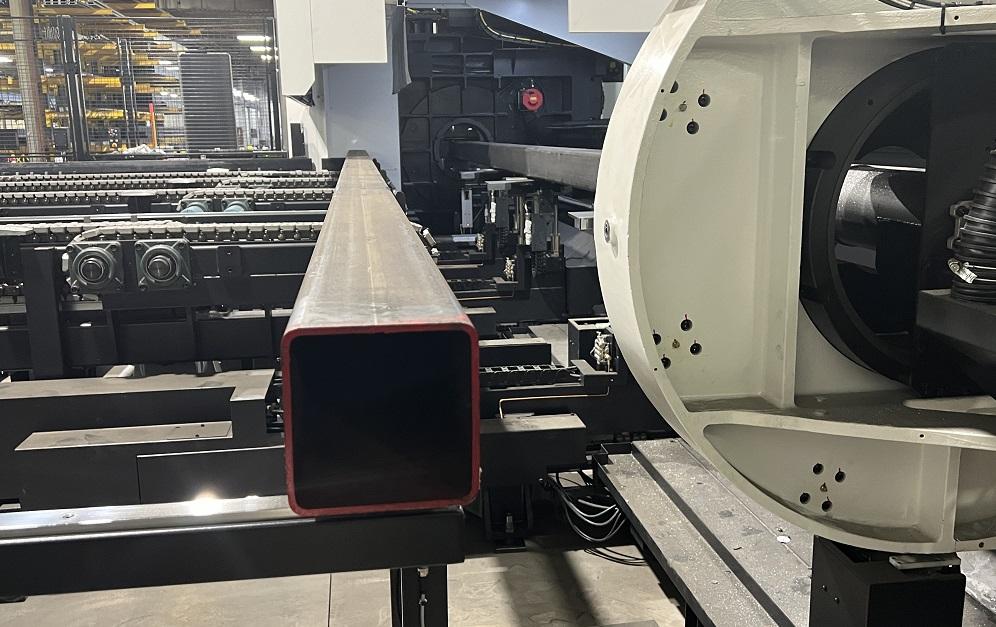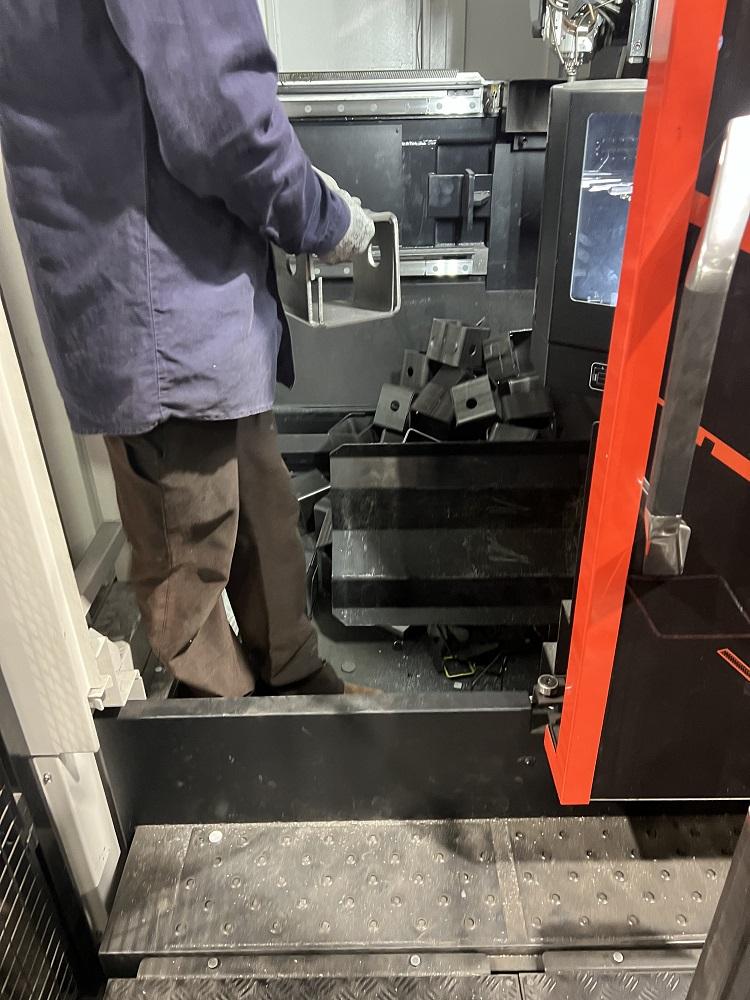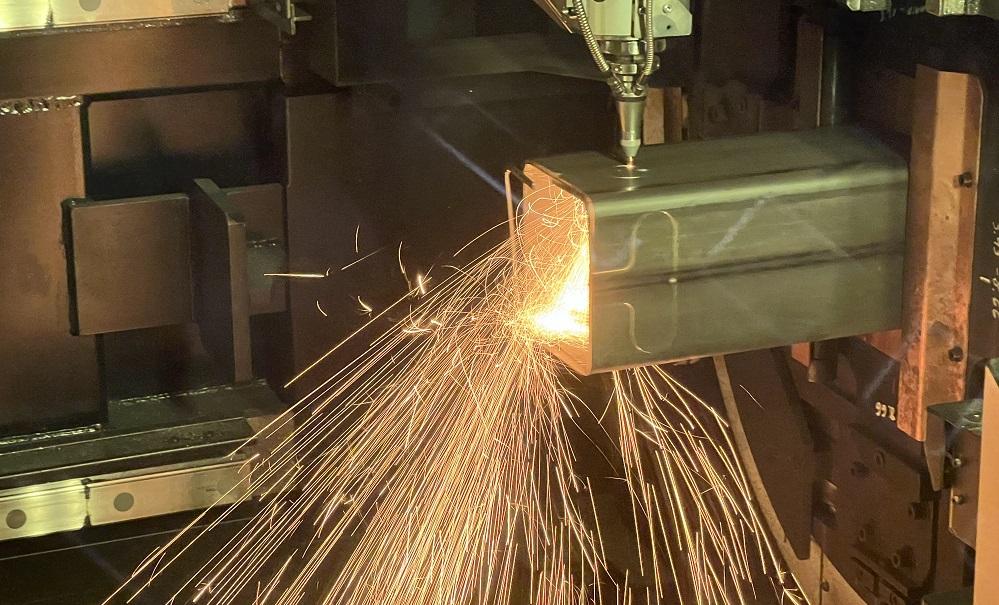Editor
- FMA
- The Fabricator
- FABTECH
- Canadian Metalworking
Categories
- Additive Manufacturing
- Aluminum Welding
- Arc Welding
- Assembly and Joining
- Automation and Robotics
- Bending and Forming
- Consumables
- Cutting and Weld Prep
- Electric Vehicles
- En Español
- Finishing
- Hydroforming
- Laser Cutting
- Laser Welding
- Machining
- Manufacturing Software
- Materials Handling
- Metals/Materials
- Oxyfuel Cutting
- Plasma Cutting
- Power Tools
- Punching and Other Holemaking
- Roll Forming
- Safety
- Sawing
- Shearing
- Shop Management
- Testing and Measuring
- Tube and Pipe Fabrication
- Tube and Pipe Production
- Waterjet Cutting
Industry Directory
Webcasts
Podcasts
FAB 40
Advertise
Subscribe
Account Login
Search
Fabricator achieves extraordinary with simple approach
Rock Run Industries buys laser tube cutter to expand success
- By Lincoln Brunner
- April 2, 2024
- Article
- Laser Cutting

Rock Run’s laser tube cutter can fabricate material up to 50 ft. long and up to 12 in. square and 16 in. round, with loading and unloading. The company also uses the laser to cut tubes as narrow as 1 in. OD.
If you traveled to a certain business park in Topeka, Ind., you might see a sign for Rock Run Industries in front of a nondescript cluster of sprawling buildings with a bunch of horse-drawn buggies in the parking lot.
And before you went in, if you weren’t careful, you might start to think that the folks inside weren’t all that savvy about business, let alone about running millions of dollars’ worth of high-tech fabrication equipment. Or worse, you might think that Rock Run somehow didn’t fit in the modern fabrication world.
On all counts, you’d be wrong. In fact, Rock Run is exactly where it wants to be—at the top of its game and growing fast.
‘Right Place, Right Time’
That comfort level starts with the company’s location. Situated in LaGrange County in northwest Indiana, Rock Run stands in the middle of a tri-county area—Elkhart, LaGrange, and Noble—that produces about 85% of the world’s RVs (in fact, most of Rock Run’s customers are within 30 miles of the shop). That thriving market has been the company’s mainstay since owner Fritz Schlabach (SLAY-baw) started it in 2008, building RV components for two customers. That customer roster quickly expanded to 23 by the end of that year.
“It started out with chassis parts,” said Schlabach, a soft-spoken but energetic man who wears the simple, sturdy clothes and distinctive beard of his Amish faith. “I was working in the floor department of the RV industry … so I knew what chassis parts they were buying. We started there and over the years, people would come to me and say, ’Hey, Fritz, we need a part that would do this or would swing around this corner. Can you come up with a way of doing this?’ And that’s kind of how we built our business.”
The fraternal nature of the RV business helped too: It can be hard to break in, but once you do, and you do good work, you’re on the A list.
“It’s nothing really scientific,” Schlabach said. “We were just at the right place, right time. The RV industry—they do a lot of things on a handshake. You just agree to do things. They won’t put an extra nickel into a part, but they will pay you and pay you on time if you deliver on time.
“When you think about it, it’s … an ideal situation. There aren’t a lot of contracts. We don’t have contracts. There are handshakes. There’s a lot of ‘Hey, you keep the parts coming and you keep them on time, and we’re going to keep buying from you.’ We build parts just on anticipating orders.”
Oh, and having the guts to start in 2008 ended up helping, as well.
Few people in business at the time want to remember 2008: the Great Recession, banks calling in loans, companies laying off people and falling off cliffs. In the metal fabrication world, white-hot demand from China sent hot-rolled coil steel prices soaring, roughly doubling the price of carbon HRC for a good portion of that year. But what sank more established businesses actually created opportunity for Schlabach.

Rock Run purchased its first-ever laser tube cutting machine to offer its customers cutting capabilities it didn’t have before and also quicker turnaround time than they might find at other nearby fabrication shops.
“I was the new guy,” Schlabach said. “I was a startup. I had no overhead. There were only about four or five us. So, it really kind of leveled the playing field.
“I decided to take a chance, and I kept my prices artificially low, knowing that I was doing that,” he recalled. “But it caught the attention of a lot of the RV [parts] buyers around here. I was just barely making any money. I couldn’t have gone on like that for too long.”
Taking Chances, Creating Business
That willingness to take calculated risk is one of the key traits that marks Rock Run to this day.
Back in 2000, years before he launched the company, Schlabach was working for an area RV manufacturer, but work was slow. And like so many entrepreneurs with a healthy work ethic, he was bored. So, he started cutting steel parts in his garage for fun. One day, he offered to help a friend who ran a fabrication shop, and he noticed the guy was spray painting parts himself.
Before long, Schlabach was asking questions and making plans.
“I said, ‘Why don’t you buy these painted?’” Schlabach recalled. “And he said, ‘My fabricator doesn’t want to paint.’ Ironically, I knew how to wet paint with automotive paints. I’d done some sandblasting and painting before that. But I didn’t know anything about metalworking. So, by the end of the day, I offered to build his parts for him and paint them and then sell them to him as a painted part instead of a raw part.”
That seed of a business grew steadily over the next eight years, and what was a part-time gig welding RV parts in his garage matured into a full-fledged business with three full-time employees. It got big enough to attract the attention of his employer, so the two parties agreed that it was probably time to part ways.
Schlabach was ready. Jumping into the business with tight margins not only got him in the door with customers who were willing to try him out, but it also forced him to watch his already-low overhead costs like a hawk. And that’s how Rock Run’s piece rate system was born.
Piece Rate Panacea
Unlike salaried employees drawing the same pay every two weeks, or hourly employees earning a certain rate no matter how much they make, piece rate employees get paid on the simplest of terms—for every part they produce. Or more accurately, they receive a percentage of the agreed-upon rate for each part they produce.
At Rock Run, that means 75% for the employees and 25% for Rock Run, no matter what the part is. The math works because Schlabach has already calculated his overhead costs for that part and built them into the price—but that’s before any markups he charges a customer. Once his overhead costs are met, whatever markups he determines the customer will pay is pure profit.

Rock Run recently commissioned its Mazak FG-400 NEO. It is the seventh laser in the company’s lineup but its first laser tube cutting machine. Its tentative plans are to add a second laser tube cutter to handle tubing smaller than 1 in. OD. Images: Lincoln Brunner
And while that 75% has to be shared with other employees who had an indirect hand in making the part—forklift drivers, office staff, engineers—the results for employees have been astounding: This past year, many employees made about $55/hr., which was down from the $75/hr. or so that they averaged the previous year.
“The beauty of it is that human nature that wants to build as many [parts] as possible to raise their pay—they’re putting 25% into the company’s bucket,” Schlabach said. “And that 25% pays all my overhead.
“The company benefits almost more than the employee does because that 25% stacks up so much faster … if you’ve got 100 employees doing that. That really makes a big difference.”
In the meantime, his employees (Rock Run has about 110)—many of whom are long-timers and know their jobs well—are automatically compensated for greater productivity. And because of their level of competency, Schlabach doesn’t worry about quality.
“They know that they’re going to get paid what the labor value of that part is, and the more parts they build, the more markups I have at the end of the day,” Schlabach said. “And I only have to buy half as much equipment as a guy that has a bunch of employees that don’t work half as fast [as mine].
“It’s an incredible system once it starts to work, but it takes the right people to make it work. But management’s got to go first. Management has to make that commitment to paying well and buying good equipment. And we have good equipment. Most of our equipment is relatively new and modern, and I think it helps attract top talent that wants to work with that type of equipment.”
Branching Out, Beefing Up
Rock Run’s commitment to investing in its employees and capital equipment—and the monetary rewards—are as plain as Schlabach’s neatly ironed shirt.
From 2009 to 2022, Rock Run Industries averaged 35% growth every year. That translated to $58 million in sales in 2022, the same year that the company decided to purchase its first laser tube cutting machine, a Mazak FG-400 NEO fiber laser that can accept and turn out workpieces up to 50 ft. long. After ordering the machine in 2022, the company was finally able to get it installed in July and commissioned in September.
The laser tube cutting system joins a long list of premium machinery the company has assembled since its inception, including 14 hydraulic press brakes, six 2D laser cutting machines, and two mechanical shears. Ever with one eye on current operations and one on the future, Schlabach decided that expansion meant two things in the short term: a new market and a new machine to serve it. Hence the purchase of a nearby steel service center in 2021 and the FG-400 NEO.
It was a move that hearkened back to Rock Run’s beginnings—trying to do whatever customers needed done.
“We were just wanting to add another machine so that our engineers have another option,” Schlabach said. “There are times when … people come to us and say, ‘Can you build this?’ Sometimes you can do things with a tube laser that you can do with hardly anything else.”
That’s more or less what the machine was designed for, according to Mazak Optonics National Sales Manager Adam Smelewski. Now in its third or fourth iteration since its introduction more than 20 years ago, the FG-400 is designed to operate as a one-stop metal processing center. The machine can process tubes with ODs up 12 in. square and 16 in. round. In addition, the four-chuck material handling system—two on the loading side, two for unloading—is designed to hold pieces rigidly so that it can fabricate accurately without position variations, no matter what the length.
Beyond tubing, it can process multiple profiles of material, including channels and I-beams. It is designed to chamfer, bevel, drill, tap, cut slots, and even machine keyholes. That spate of operations typically requires multiple machines.
“We’re doing it all in one,” Smelewski said. “You put your raw material on, you spit your finished part out.”
That essentially was what Rock Run wanted to offer customers of the service center business that it purchased in 2021. Instead of installing the laser at that facility, the company decided to keep it at its plant in Topeka, but the goal remains the same—serve new market areas with new capabilities and be quick enough to beat larger operations to the punch.
“They also have tube lasers,” Schlabach said of larger service centers that now are his competitors. “Something’s got to set us apart. The problem is … you might have to wait three weeks to get on their tube laser schedule. We’re hoping to be a little easier to work with and let that customer be closer to the process. We want to be nimble with great equipment is about what it amounts to.
“The biggest driver is, what can we invest in to really expand?” Schlabach said. “I kind of felt like the last couple of years, we were setting the stage for the next period of growth, and a tube laser in our arsenal of equipment is one of the things.”
About the Author

Lincoln Brunner
2135 Point Blvd.
Elgin, IL 60123
(815)-227-8243
Lincoln Brunner is editor of The Tube & Pipe Journal. This is his second stint at TPJ, where he served as an editor for two years before helping launch thefabricator.com as FMA's first web content manager. After that very rewarding experience, he worked for 17 years as an international journalist and communications director in the nonprofit sector. He is a published author and has written extensively about all facets of the metal fabrication industry.
About the Publication
Related Companies
subscribe now

The Tube and Pipe Journal became the first magazine dedicated to serving the metal tube and pipe industry in 1990. Today, it remains the only North American publication devoted to this industry, and it has become the most trusted source of information for tube and pipe professionals.
start your free subscription- Stay connected from anywhere

Easily access valuable industry resources now with full access to the digital edition of The Fabricator.

Easily access valuable industry resources now with full access to the digital edition of The Welder.

Easily access valuable industry resources now with full access to the digital edition of The Tube and Pipe Journal.
- Podcasting
- Podcast:
- The Fabricator Podcast
- Published:
- 04/16/2024
- Running Time:
- 63:29
In this episode of The Fabricator Podcast, Caleb Chamberlain, co-founder and CEO of OSH Cut, discusses his company’s...
- Trending Articles
Team Industries names director of advanced technology and manufacturing

Orbital tube welding webinar to be held April 23

Zekelman Industries to invest $120 million in Arkansas expansion

Push-feeding saw station cuts nonferrous metals

3D laser tube cutting system available in 3, 4, or 5 kW

- Industry Events
16th Annual Safety Conference
- April 30 - May 1, 2024
- Elgin,
Pipe and Tube Conference
- May 21 - 22, 2024
- Omaha, NE
World-Class Roll Forming Workshop
- June 5 - 6, 2024
- Louisville, KY
Advanced Laser Application Workshop
- June 25 - 27, 2024
- Novi, MI


























